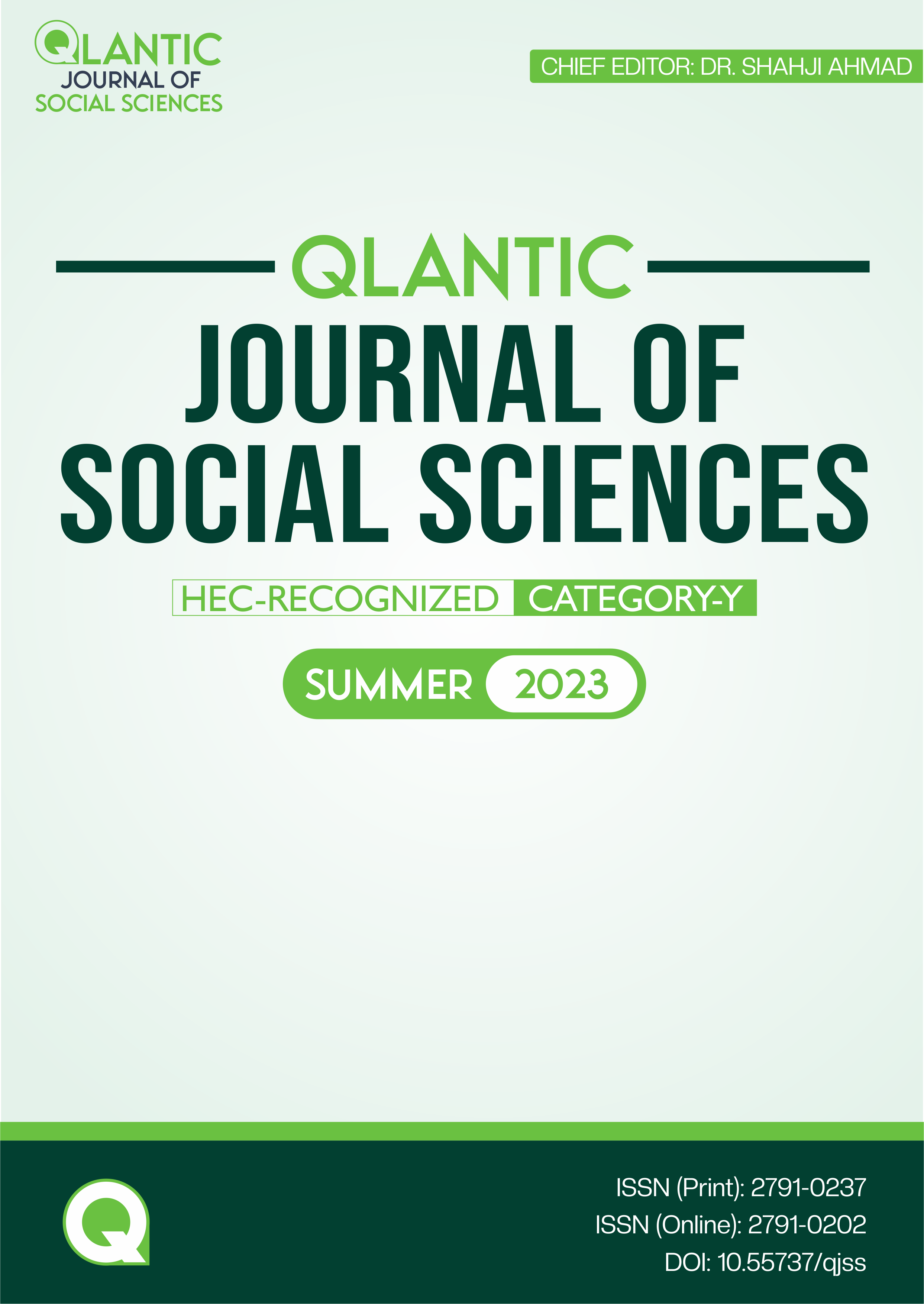Socioeconomic and Religious Tension Mitigate Exchange Rate: Empirical Evidence from Pakistan
DOI:
https://doi.org/10.55737/qjss.647030973Keywords:
Socioeconomic, Religious Tension, Exchange Rate, ARDL, NARDL, PakistanAbstract
The study investigated the socioeconomic and religious tension effect on the exchange rate of Pakistan. As well as ethnic tension, law and order, political and government stability. For this purpose, use time series data and time period 1996-2017. The econometric approach ARDL and NARDl approaches are used. The study findings, Socioeconomic conditions, government, political stability, and law and order are positive and statistically significant. Thus, the religious and ethnic factors are also negative and statistically significant. In the case of NARDL, the projected variables are positive and negative, with a significant impact on the exchange rate of Pakistan. The study suggests the government and political stability of the state. As well as reduce ethnic and religious issues in appropriate ways, such as by increasing religious education and declining ethnic hatred.
References
Bahmani-Oskooee, M., Hadj Amor, T., Nouira, R., & Rault, C. (2018). Political risk and real exchange rate: What can we learn from recent developments in panel data econometrics for emerging and developing countries? Journal of Quantitative Economics, 17(4), 741-762. https://doi.org/10.1007/s40953-018-0145-4
Benedict, A., Mafika, S., Tutu, K. B., & Selase, A. M. (2022). The effects of political risk on foreign exchange demand: Evidence from Zimbabwe. Cogent Economics & Finance, 10(1). https://doi.org/10.1080/23322039.2022.2111806
Butt, S., Ramakrishnan, S., Loganathan, N., & Chohan, M. A. (2020). Evaluating the exchange rate and commodity price nexus in Malaysia: Evidence from the threshold cointegration approach. Financial Innovation, 6(1). https://doi.org/10.1186/s40854-020-00181-6
Compaoré, A., Mlachila, M. M., Ouedraogo, R., & Sourouema, S. (2020). The impact of conflict and political instability on banking crises in developing countries. International Monetary Fund.
Denzel, M. A. (2017). Handbook of world exchange rates, 1590–1914. Routledge.
Elkomy, S., Ingham, H., & Read, R. (2015). Economic, Institutional & Political Determinants of FDI Growth Effects in Emerging & Developing Countries. https://core.ac.uk/download/pdf/42415403.pdf
Fisher, M. J., & Marshall, A. P. (2009). Understanding descriptive statistics. Australian Critical Care, 22(2), 93-97. https://doi.org/10.1016/j.aucc.2008.11.003
Frankel, J. A. (1979). A Test of the Existence of the Risk Premium in the Foreign Exchange Market vs. The Hypothesis of Perfect Substitulability.
Frankel, J. A. (1979). On the Mark: A Theory of Floating Exchange Rates Based on Real Interest Differentials. The American Economic Review, 69(4), 610–622. http://www.jstor.org/stable/1808707
Gujarati, D. N. (2022). Basic econometrics. Prentice Hall.
Gul, A., & Khan, A. W. (2021), The Effect of Small-Scale Industries on Employment Level in Pakistan, Journal of Research and Reviews in Social Sciences Pakistan, 4(2), 1393-1404. https://journal.kinnaird.edu.pk/wp-content/uploads/2021/12/11.-Akhtar-Gul-1.pdf
Gul, A., Khan, S. U., & Abbasi, R. A. (2023). Vicious Circle of Health Expenditure: Time Series Evidence from Pakistan. Journal of Contemporary Macroeconomic Issues, 4(1), 57–77. https://ojs.scekr.org/index.php/jcmi/article/view/99
Gul, A., Sadiq, S., & Khan, S. U. (2023). Conflicts and The Structure of Economy: A Case of Trade in Pakistan. Journal of Development and Social Sciences, 4(4), 23-42. https://doi.org/10.47205/jdss.2023(4-IV)03
Kaur, P., Stoltzfus, J., & Yellapu, V. (2018). Descriptive statistics. International Journal of Academic Medicine, 4(1), 60. https://doi.org/10.4103/ijam.ijam_7_18
Nordal, K. B. (2001). Country risk, country risk indices and valuation of FDI: A real options approach. Emerging Markets Review, 2(3), 197-217. https://doi.org/10.1016/s1566-0141(01)00017-6
PHILLIPS, P. C., & PERRON, P. (1988). undefined. Biometrika, 75(2), 335-346. https://doi.org/10.1093/biomet/75.2.335
Ramakrishnan, S. , Butt, S. & Anuar, M. A. (2017). The Impact of Macroeconomic, Oil Prices and Socio-economic Factors on Exchange Rate in Pakistan: An Auto Regressive Distributed Lag Approach . International Journal of Economics and Financial Issues, 7(1), 489-499. https://dergipark.org.tr/en/pub/ijefi/issue/32002/353226
Rauf, A., & Khan, A. A. (2017). Impact of foreign debt on economic growth: Evidence from Pakistan. Asian Economic and Financial Review, 7(10), 1005-1013. https://doi.org/10.18488/journal.aefr.2017.710.1005.1013
Rehman, R., Sadiq, S., Khan, S. U., & Gul, A. (2023). Long Term Trends in Rainfall and Temperature Effects on Food Security in Pakistan: An Analysis of 75 Years (1947-2021). Qlantic Journal of Social Sciences, 4(3), 55-68. https://doi/org/10.55737/qjss.000490202
SAID, S. E., & DICKEY, D. A. (1984). Testing for unit roots in autoregressive-moving average models of unknown order. Biometrika, 71(3), 599-607. https://doi.org/10.1093/biomet/71.3.599
Sifat, U., K, Khan, Z., K, & Gul, A. (2023). Democracy's Role in Shaping Pakistan's Economic Growth: An Empirical Evidence from Pakistan. International Journal of Contemporary issues in social sciences, 2(3), 356-367.
Venâncio de Vasconcelos, M. (2020). Political stability and bank flows: New evidence. Journal of Risk and Financial Management, 13(3), 56. https://doi.org/10.3390/jrfm13030056
Willett, T. D., Chiu, E. M., & Walter, S. (2014). Fixed exchange rate regimes and financial markets as sources of macroeconomic discipline. Handbook of the International Political Economy of Monetary Relations, 285-303. https://doi.org/10.4337/9780857938374.00022




